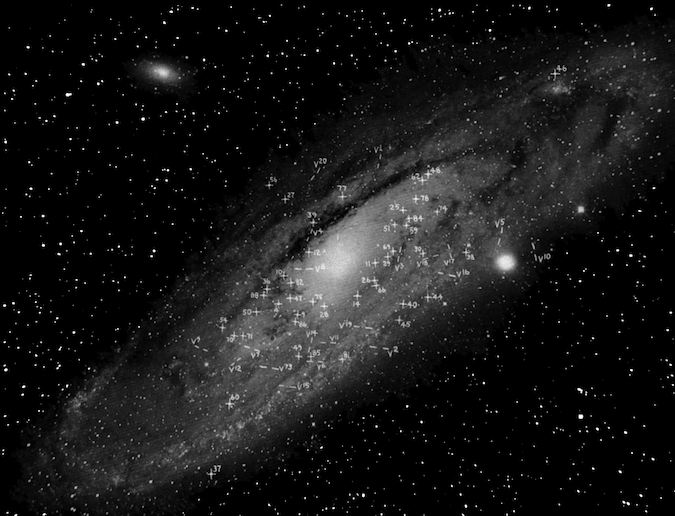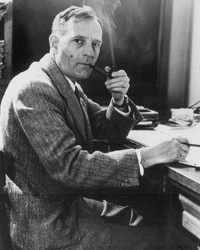Andromeda Nebula Lies Outside Milky Way Galaxy
Spiral Nebulae are indeed "Island Universes"
Astronomer Edwin Hubble, of the Mount Wilson Observatory at Pasadena, California, has solved the mystery of the spiral nebulae. The spiral nebulae look like hazy pin-wheels in the sky. He has determined that these objects are much more distant than previously thought. Therefore, they are distant galaxies and not part of our own Milky Way galaxy. In the process, Dr. Hubble was also able to determine the distance to the spiral Andromeda nebula.

Image credit: Hubble, ApJ, 69, 103 (1929)
Hubble's Annotated image of the Great Andromeda Nebula showing the locations of variable stars.
Dr. Hubble's observations support the views Dr. Heber Curtis expressed in a debate with Dr. Harlow Shapley in 1920. Curtis stated that bright diffuse nebulae are fairly close to Earth and are part of the Milky Way, while spiral nebulae are at great distances and not part of the Milky Way.
On December 30, 1924, Hubble announced that he had taken photographs of a few bright spiral nebulae with the Mount Wilson Hooker telescope, the largest reflecting telescope in the world. According to Dr. Hubble, "The 100 inch reflector partially resolved a few of the nearest, neighboring [spiral] nebulae into swarms of stars." One of the nearby nebulae Dr. Hubble photographed was the Andromeda nebula. He estimates it is as large, and holds as much matter, as the Milky Way. It may contain some three to four billion stars that produce one-billion times the light of the Sun.
These photographs showed there were individual stars in the nebula. They also showed some of the stars changed in brightness over time. Known as Cepheid variable stars, these stars were the key to determining distances to the nebulae. The true brightness of the Cepheids in the nebulae Hubble studied was known from how the Cepheid changes its brightness. Scientists had already known exactly how light dims over distance. The distance to the star, and the nebula it is located in, can be found by comparing the apparent brightness of these stars to their true brightness.

Image credit: Hale Observatories, courtesy AIP Emilio Segre Visual Archives
Edwin Hubble
Dr. Hubble's work builds on earlier observations by Miss Henrietta Swan Leavitt of the Harvard College Observatory and by Dr. Harlow Shapley of the Mount Wilson Observatory.
In 1912, Miss Leavitt was the first to recognize the importance of Cepheid variables. They are giant stars, and each varies in brightness over time. Cepheids are named after the first such star of its type found: Delta Cephei in the constellation Cepheus. While studying Cepheids in the Small Magellanic Cloud, Miss Leavitt noticed that the Cepheids would brighten, then fade, and then brighten again. The length of time (the period) it took for the star to go through this cycle was directly related to its true brightness: the longer the period, the brighter the star. The Small Magellanic Cloud is a large group of stars visible in the southern hemisphere. Since all of these stars were in the Small Magellanic Cloud, they were at roughly the same distance from the Earth. Each Cepheid's true brightness was directly related to its period.
Soon after Miss Leavitt's discovery, Dr. Shapley began searching for Cepheids in globular clusters in our own Milky Way galaxy. Globular clusters are sphere-shaped groups of tens of thousands of densely packed stars. He used the period-brightness relationship to determine the distance to more than 230 globular clusters. He assumed that Cepheids in distant globular clusters act the same as nearby Cepheids. Based on that assumption, he found the most distant clusters in the Milky Way Galaxy are about 200,000 light years away.
By studying the periods of the Cepheids in the Andromeda nebula, Dr. Hubble was able to determine the true brightness (or absolute magnitude) of each. He then made observations of their apparent brightness (or apparent magnitude). Once he knew the difference between how bright a star appeared and how bright it truly was, he was able to calculate its distance from the Earth. He found Andromeda to be 900,000 light years away – the most distant object known to-date. •



